Project Management and Principles: Full Redevelopment and Construction of Mooloolaba Holiday Park including Coastal Pathway Upgrades
VerifiedAdded on 2023/03/31
|18
|3830
|206
AI Summary
This document discusses the project charter, scope, constraints, budget, schedule, deliverables, success criteria, and the role of a project manager in the redevelopment and construction of Mooloolaba Holiday Park including Coastal Pathway Upgrades.
Contribute Materials
Your contribution can guide someone’s learning journey. Share your
documents today.
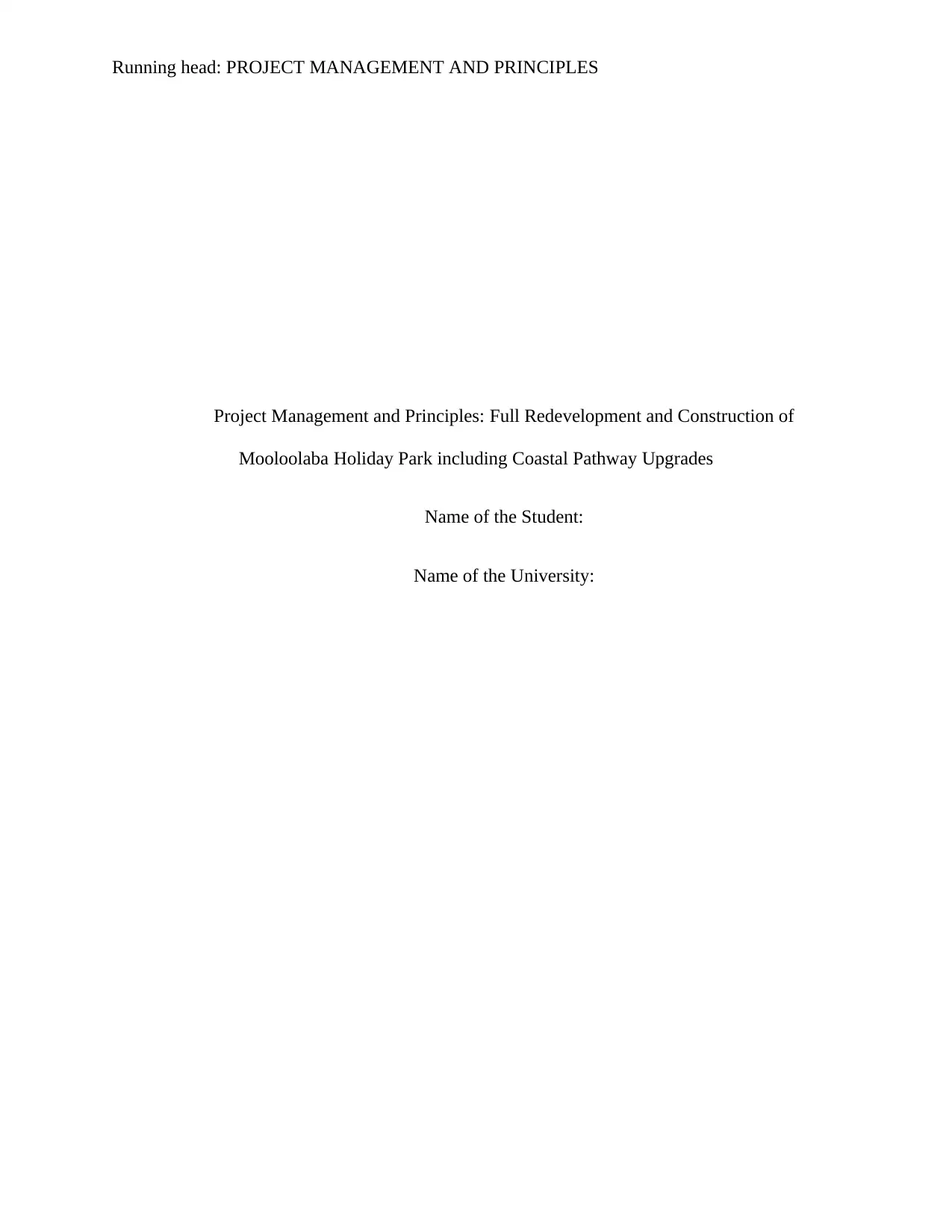
Running head: PROJECT MANAGEMENT AND PRINCIPLES
Project Management and Principles: Full Redevelopment and Construction of
Mooloolaba Holiday Park including Coastal Pathway Upgrades
Name of the Student:
Name of the University:
Project Management and Principles: Full Redevelopment and Construction of
Mooloolaba Holiday Park including Coastal Pathway Upgrades
Name of the Student:
Name of the University:
Secure Best Marks with AI Grader
Need help grading? Try our AI Grader for instant feedback on your assignments.
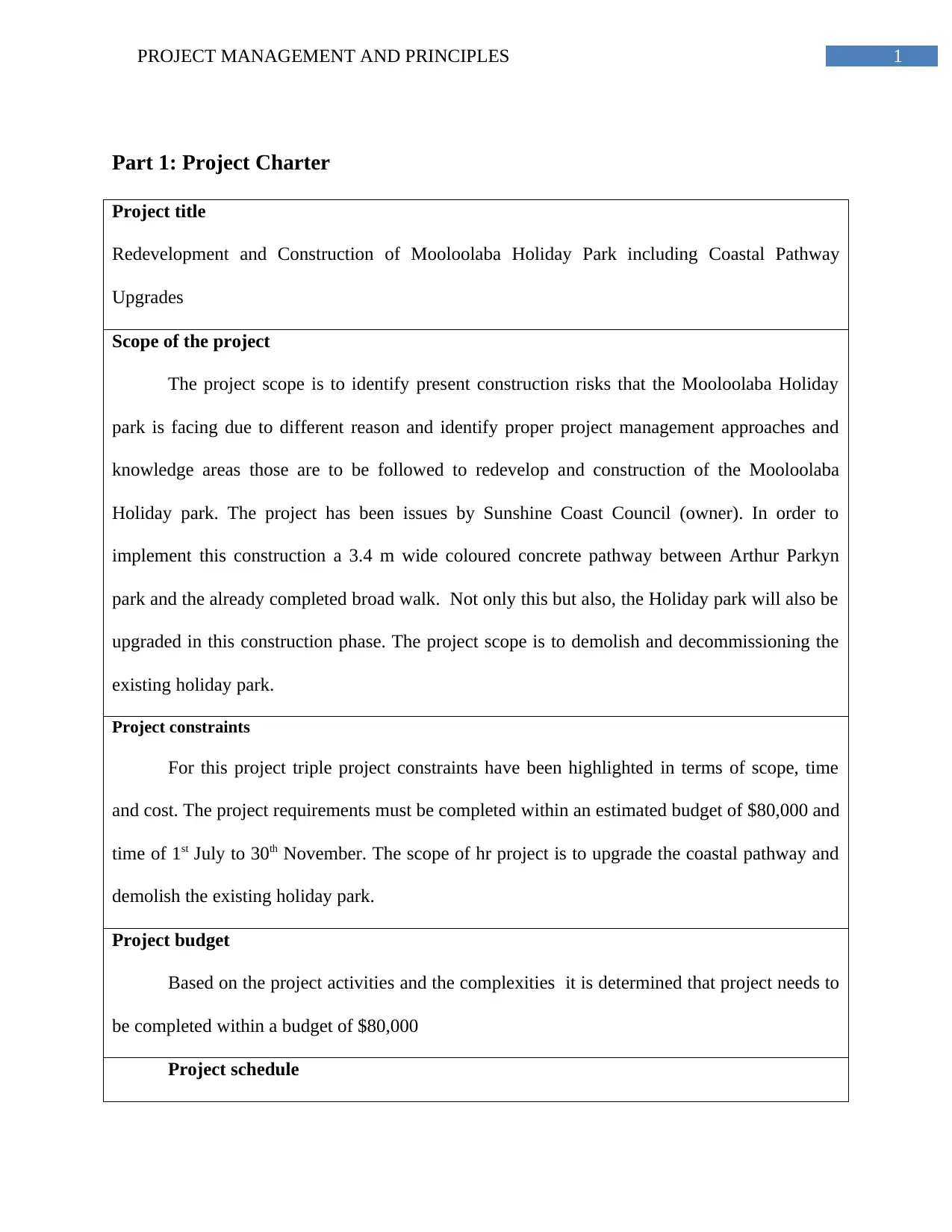
1PROJECT MANAGEMENT AND PRINCIPLES
Part 1: Project Charter
Project title
Redevelopment and Construction of Mooloolaba Holiday Park including Coastal Pathway
Upgrades
Scope of the project
The project scope is to identify present construction risks that the Mooloolaba Holiday
park is facing due to different reason and identify proper project management approaches and
knowledge areas those are to be followed to redevelop and construction of the Mooloolaba
Holiday park. The project has been issues by Sunshine Coast Council (owner). In order to
implement this construction a 3.4 m wide coloured concrete pathway between Arthur Parkyn
park and the already completed broad walk. Not only this but also, the Holiday park will also be
upgraded in this construction phase. The project scope is to demolish and decommissioning the
existing holiday park.
Project constraints
For this project triple project constraints have been highlighted in terms of scope, time
and cost. The project requirements must be completed within an estimated budget of $80,000 and
time of 1st July to 30th November. The scope of hr project is to upgrade the coastal pathway and
demolish the existing holiday park.
Project budget
Based on the project activities and the complexities it is determined that project needs to
be completed within a budget of $80,000
Project schedule
Part 1: Project Charter
Project title
Redevelopment and Construction of Mooloolaba Holiday Park including Coastal Pathway
Upgrades
Scope of the project
The project scope is to identify present construction risks that the Mooloolaba Holiday
park is facing due to different reason and identify proper project management approaches and
knowledge areas those are to be followed to redevelop and construction of the Mooloolaba
Holiday park. The project has been issues by Sunshine Coast Council (owner). In order to
implement this construction a 3.4 m wide coloured concrete pathway between Arthur Parkyn
park and the already completed broad walk. Not only this but also, the Holiday park will also be
upgraded in this construction phase. The project scope is to demolish and decommissioning the
existing holiday park.
Project constraints
For this project triple project constraints have been highlighted in terms of scope, time
and cost. The project requirements must be completed within an estimated budget of $80,000 and
time of 1st July to 30th November. The scope of hr project is to upgrade the coastal pathway and
demolish the existing holiday park.
Project budget
Based on the project activities and the complexities it is determined that project needs to
be completed within a budget of $80,000
Project schedule
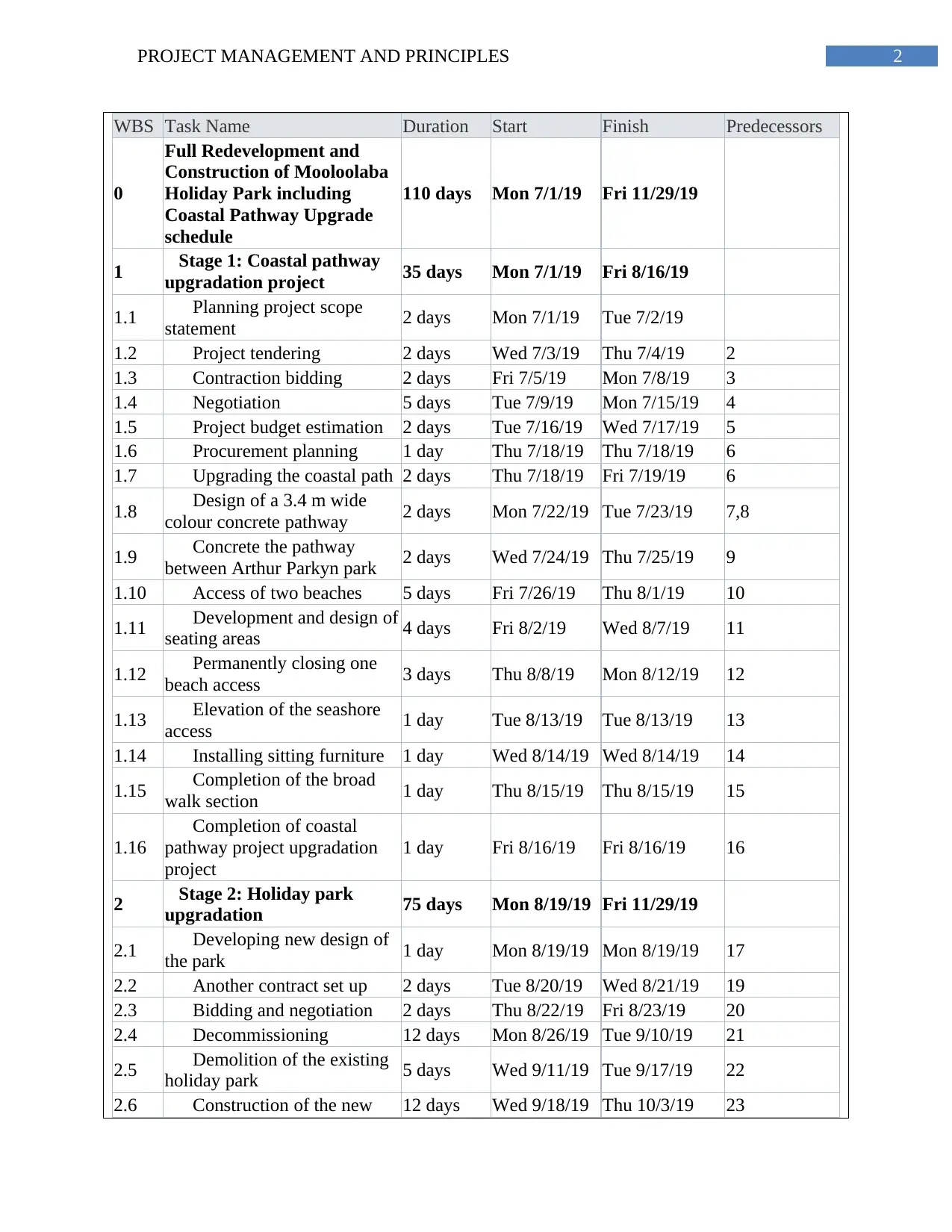
2PROJECT MANAGEMENT AND PRINCIPLES
WBS Task Name Duration Start Finish Predecessors
0
Full Redevelopment and
Construction of Mooloolaba
Holiday Park including
Coastal Pathway Upgrade
schedule
110 days Mon 7/1/19 Fri 11/29/19
1 Stage 1: Coastal pathway
upgradation project 35 days Mon 7/1/19 Fri 8/16/19
1.1 Planning project scope
statement 2 days Mon 7/1/19 Tue 7/2/19
1.2 Project tendering 2 days Wed 7/3/19 Thu 7/4/19 2
1.3 Contraction bidding 2 days Fri 7/5/19 Mon 7/8/19 3
1.4 Negotiation 5 days Tue 7/9/19 Mon 7/15/19 4
1.5 Project budget estimation 2 days Tue 7/16/19 Wed 7/17/19 5
1.6 Procurement planning 1 day Thu 7/18/19 Thu 7/18/19 6
1.7 Upgrading the coastal path 2 days Thu 7/18/19 Fri 7/19/19 6
1.8 Design of a 3.4 m wide
colour concrete pathway 2 days Mon 7/22/19 Tue 7/23/19 7,8
1.9 Concrete the pathway
between Arthur Parkyn park 2 days Wed 7/24/19 Thu 7/25/19 9
1.10 Access of two beaches 5 days Fri 7/26/19 Thu 8/1/19 10
1.11 Development and design of
seating areas 4 days Fri 8/2/19 Wed 8/7/19 11
1.12 Permanently closing one
beach access 3 days Thu 8/8/19 Mon 8/12/19 12
1.13 Elevation of the seashore
access 1 day Tue 8/13/19 Tue 8/13/19 13
1.14 Installing sitting furniture 1 day Wed 8/14/19 Wed 8/14/19 14
1.15 Completion of the broad
walk section 1 day Thu 8/15/19 Thu 8/15/19 15
1.16
Completion of coastal
pathway project upgradation
project
1 day Fri 8/16/19 Fri 8/16/19 16
2 Stage 2: Holiday park
upgradation 75 days Mon 8/19/19 Fri 11/29/19
2.1 Developing new design of
the park 1 day Mon 8/19/19 Mon 8/19/19 17
2.2 Another contract set up 2 days Tue 8/20/19 Wed 8/21/19 19
2.3 Bidding and negotiation 2 days Thu 8/22/19 Fri 8/23/19 20
2.4 Decommissioning 12 days Mon 8/26/19 Tue 9/10/19 21
2.5 Demolition of the existing
holiday park 5 days Wed 9/11/19 Tue 9/17/19 22
2.6 Construction of the new 12 days Wed 9/18/19 Thu 10/3/19 23
WBS Task Name Duration Start Finish Predecessors
0
Full Redevelopment and
Construction of Mooloolaba
Holiday Park including
Coastal Pathway Upgrade
schedule
110 days Mon 7/1/19 Fri 11/29/19
1 Stage 1: Coastal pathway
upgradation project 35 days Mon 7/1/19 Fri 8/16/19
1.1 Planning project scope
statement 2 days Mon 7/1/19 Tue 7/2/19
1.2 Project tendering 2 days Wed 7/3/19 Thu 7/4/19 2
1.3 Contraction bidding 2 days Fri 7/5/19 Mon 7/8/19 3
1.4 Negotiation 5 days Tue 7/9/19 Mon 7/15/19 4
1.5 Project budget estimation 2 days Tue 7/16/19 Wed 7/17/19 5
1.6 Procurement planning 1 day Thu 7/18/19 Thu 7/18/19 6
1.7 Upgrading the coastal path 2 days Thu 7/18/19 Fri 7/19/19 6
1.8 Design of a 3.4 m wide
colour concrete pathway 2 days Mon 7/22/19 Tue 7/23/19 7,8
1.9 Concrete the pathway
between Arthur Parkyn park 2 days Wed 7/24/19 Thu 7/25/19 9
1.10 Access of two beaches 5 days Fri 7/26/19 Thu 8/1/19 10
1.11 Development and design of
seating areas 4 days Fri 8/2/19 Wed 8/7/19 11
1.12 Permanently closing one
beach access 3 days Thu 8/8/19 Mon 8/12/19 12
1.13 Elevation of the seashore
access 1 day Tue 8/13/19 Tue 8/13/19 13
1.14 Installing sitting furniture 1 day Wed 8/14/19 Wed 8/14/19 14
1.15 Completion of the broad
walk section 1 day Thu 8/15/19 Thu 8/15/19 15
1.16
Completion of coastal
pathway project upgradation
project
1 day Fri 8/16/19 Fri 8/16/19 16
2 Stage 2: Holiday park
upgradation 75 days Mon 8/19/19 Fri 11/29/19
2.1 Developing new design of
the park 1 day Mon 8/19/19 Mon 8/19/19 17
2.2 Another contract set up 2 days Tue 8/20/19 Wed 8/21/19 19
2.3 Bidding and negotiation 2 days Thu 8/22/19 Fri 8/23/19 20
2.4 Decommissioning 12 days Mon 8/26/19 Tue 9/10/19 21
2.5 Demolition of the existing
holiday park 5 days Wed 9/11/19 Tue 9/17/19 22
2.6 Construction of the new 12 days Wed 9/18/19 Thu 10/3/19 23

3PROJECT MANAGEMENT AND PRINCIPLES
road
2.7 Concrete of the hardstand
sites 5 days Fri 10/4/19 Thu 10/10/19 24
2.8 Construction of new
amenities 5 days Fri 10/11/19 Thu 10/17/19 25
2.9 Designing camp kitchen 9 days Fri 10/18/19 Wed 10/30/19 26
2.10 Designing of the office
area 6 days Thu 10/31/19 Thu 11/7/19 27
2.11 Design of the residence
area 6 days Fri 11/8/19 Fri 11/15/19 28
2.12 Completion of holiday park
upgradation project 10 days Mon 11/18/19 Fri 11/29/19 29
Project deliverable
Stage 1: upgrading the coastal pathway
Stage 2: Upgrading the holiday park
Project Success criteria
The project should be accomplished within an assigned time and cost
The plan should meet the primary objectives and owners expectations
The project must ensure success and long term sustainability
Part 2: Short answer type question
Answer to Question 1
The role of project manager and project management prcatices are interrelated to each
other which implies that to implement a project successfully within assigned time and estimated
budget, the project managers should conduct the project team affiliates and make them work as a
team (Marcelino-Sadaba et al. 2014). The role of a project manager is nowhere much different
road
2.7 Concrete of the hardstand
sites 5 days Fri 10/4/19 Thu 10/10/19 24
2.8 Construction of new
amenities 5 days Fri 10/11/19 Thu 10/17/19 25
2.9 Designing camp kitchen 9 days Fri 10/18/19 Wed 10/30/19 26
2.10 Designing of the office
area 6 days Thu 10/31/19 Thu 11/7/19 27
2.11 Design of the residence
area 6 days Fri 11/8/19 Fri 11/15/19 28
2.12 Completion of holiday park
upgradation project 10 days Mon 11/18/19 Fri 11/29/19 29
Project deliverable
Stage 1: upgrading the coastal pathway
Stage 2: Upgrading the holiday park
Project Success criteria
The project should be accomplished within an assigned time and cost
The plan should meet the primary objectives and owners expectations
The project must ensure success and long term sustainability
Part 2: Short answer type question
Answer to Question 1
The role of project manager and project management prcatices are interrelated to each
other which implies that to implement a project successfully within assigned time and estimated
budget, the project managers should conduct the project team affiliates and make them work as a
team (Marcelino-Sadaba et al. 2014). The role of a project manager is nowhere much different
Secure Best Marks with AI Grader
Need help grading? Try our AI Grader for instant feedback on your assignments.
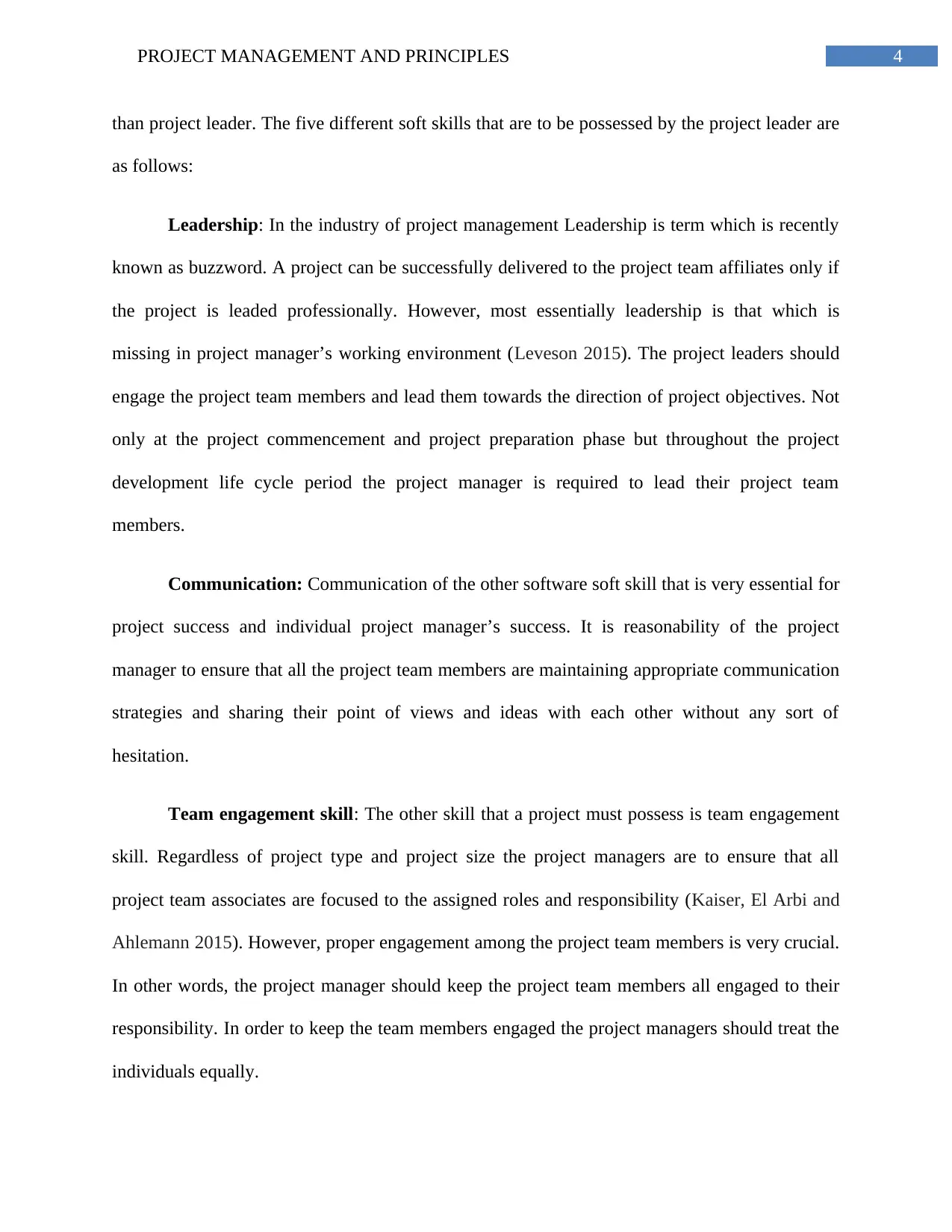
4PROJECT MANAGEMENT AND PRINCIPLES
than project leader. The five different soft skills that are to be possessed by the project leader are
as follows:
Leadership: In the industry of project management Leadership is term which is recently
known as buzzword. A project can be successfully delivered to the project team affiliates only if
the project is leaded professionally. However, most essentially leadership is that which is
missing in project manager’s working environment (Leveson 2015). The project leaders should
engage the project team members and lead them towards the direction of project objectives. Not
only at the project commencement and project preparation phase but throughout the project
development life cycle period the project manager is required to lead their project team
members.
Communication: Communication of the other software soft skill that is very essential for
project success and individual project manager’s success. It is reasonability of the project
manager to ensure that all the project team members are maintaining appropriate communication
strategies and sharing their point of views and ideas with each other without any sort of
hesitation.
Team engagement skill: The other skill that a project must possess is team engagement
skill. Regardless of project type and project size the project managers are to ensure that all
project team associates are focused to the assigned roles and responsibility (Kaiser, El Arbi and
Ahlemann 2015). However, proper engagement among the project team members is very crucial.
In other words, the project manager should keep the project team members all engaged to their
responsibility. In order to keep the team members engaged the project managers should treat the
individuals equally.
than project leader. The five different soft skills that are to be possessed by the project leader are
as follows:
Leadership: In the industry of project management Leadership is term which is recently
known as buzzword. A project can be successfully delivered to the project team affiliates only if
the project is leaded professionally. However, most essentially leadership is that which is
missing in project manager’s working environment (Leveson 2015). The project leaders should
engage the project team members and lead them towards the direction of project objectives. Not
only at the project commencement and project preparation phase but throughout the project
development life cycle period the project manager is required to lead their project team
members.
Communication: Communication of the other software soft skill that is very essential for
project success and individual project manager’s success. It is reasonability of the project
manager to ensure that all the project team members are maintaining appropriate communication
strategies and sharing their point of views and ideas with each other without any sort of
hesitation.
Team engagement skill: The other skill that a project must possess is team engagement
skill. Regardless of project type and project size the project managers are to ensure that all
project team associates are focused to the assigned roles and responsibility (Kaiser, El Arbi and
Ahlemann 2015). However, proper engagement among the project team members is very crucial.
In other words, the project manager should keep the project team members all engaged to their
responsibility. In order to keep the team members engaged the project managers should treat the
individuals equally.
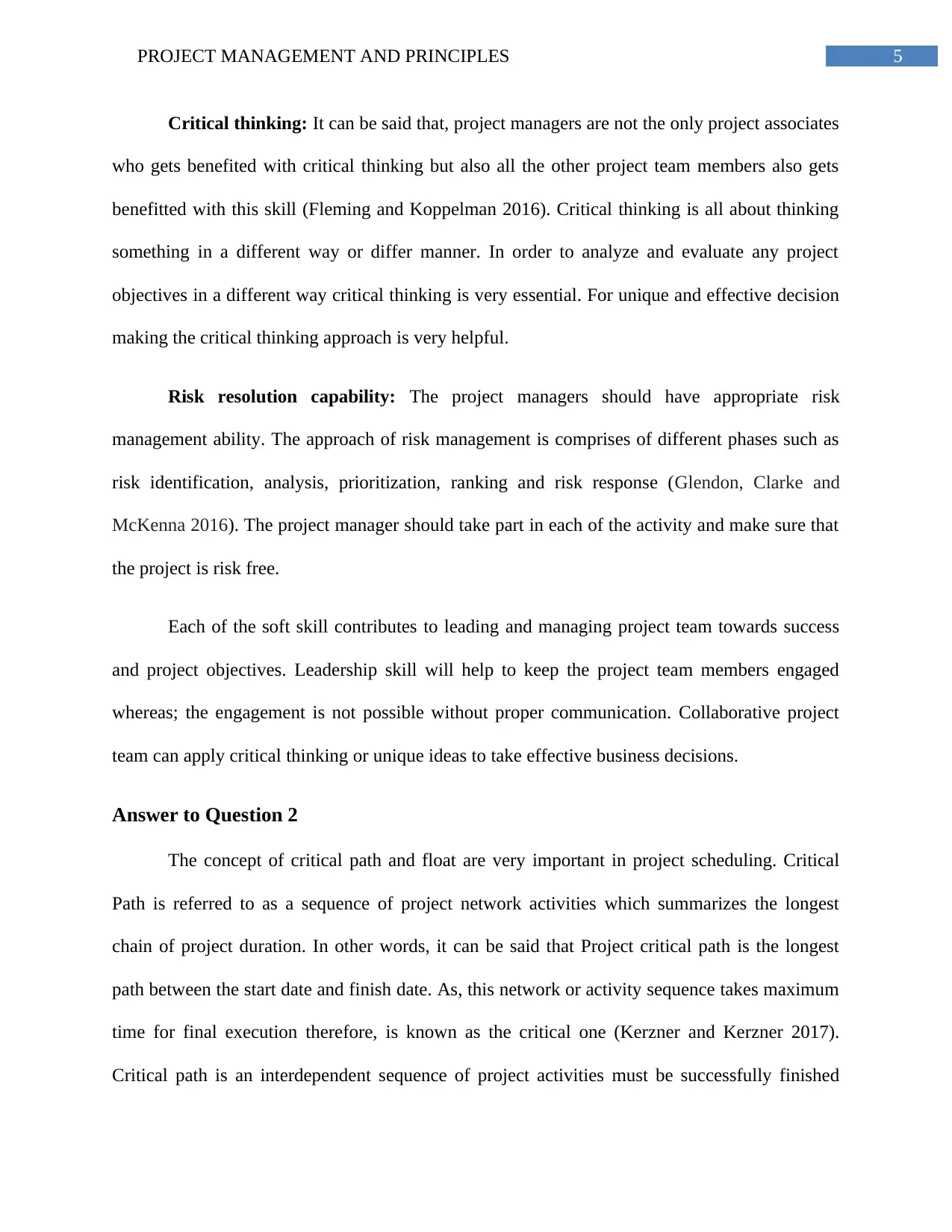
5PROJECT MANAGEMENT AND PRINCIPLES
Critical thinking: It can be said that, project managers are not the only project associates
who gets benefited with critical thinking but also all the other project team members also gets
benefitted with this skill (Fleming and Koppelman 2016). Critical thinking is all about thinking
something in a different way or differ manner. In order to analyze and evaluate any project
objectives in a different way critical thinking is very essential. For unique and effective decision
making the critical thinking approach is very helpful.
Risk resolution capability: The project managers should have appropriate risk
management ability. The approach of risk management is comprises of different phases such as
risk identification, analysis, prioritization, ranking and risk response (Glendon, Clarke and
McKenna 2016). The project manager should take part in each of the activity and make sure that
the project is risk free.
Each of the soft skill contributes to leading and managing project team towards success
and project objectives. Leadership skill will help to keep the project team members engaged
whereas; the engagement is not possible without proper communication. Collaborative project
team can apply critical thinking or unique ideas to take effective business decisions.
Answer to Question 2
The concept of critical path and float are very important in project scheduling. Critical
Path is referred to as a sequence of project network activities which summarizes the longest
chain of project duration. In other words, it can be said that Project critical path is the longest
path between the start date and finish date. As, this network or activity sequence takes maximum
time for final execution therefore, is known as the critical one (Kerzner and Kerzner 2017).
Critical path is an interdependent sequence of project activities must be successfully finished
Critical thinking: It can be said that, project managers are not the only project associates
who gets benefited with critical thinking but also all the other project team members also gets
benefitted with this skill (Fleming and Koppelman 2016). Critical thinking is all about thinking
something in a different way or differ manner. In order to analyze and evaluate any project
objectives in a different way critical thinking is very essential. For unique and effective decision
making the critical thinking approach is very helpful.
Risk resolution capability: The project managers should have appropriate risk
management ability. The approach of risk management is comprises of different phases such as
risk identification, analysis, prioritization, ranking and risk response (Glendon, Clarke and
McKenna 2016). The project manager should take part in each of the activity and make sure that
the project is risk free.
Each of the soft skill contributes to leading and managing project team towards success
and project objectives. Leadership skill will help to keep the project team members engaged
whereas; the engagement is not possible without proper communication. Collaborative project
team can apply critical thinking or unique ideas to take effective business decisions.
Answer to Question 2
The concept of critical path and float are very important in project scheduling. Critical
Path is referred to as a sequence of project network activities which summarizes the longest
chain of project duration. In other words, it can be said that Project critical path is the longest
path between the start date and finish date. As, this network or activity sequence takes maximum
time for final execution therefore, is known as the critical one (Kerzner and Kerzner 2017).
Critical path is an interdependent sequence of project activities must be successfully finished

6PROJECT MANAGEMENT AND PRINCIPLES
before the accomplishment of the project. This is the longest duration or longest path between
the project start and finish dates. In order to scheduling project tasks Critical Path Method s used
by the project managers and project team members.
Importance of CP
It helps to prioritize project key tasks
It helps to assign project deadline
It helps t accomplish projects within assigned time and budget
Importance of Float: Project float or slack is the time by which a task of a project
schedule can be delayed before it may affect the project outcomes. In order to schedule specific
project tasks float calculation is essential
Critical path calculation method:
In order to calculate critical path or using Critical Path Method project schedule can be
calculated easily. Based on the project network or project connection CPM can be calculated
(Elzamly and Hussin 2015). Some terms or figures that are essential for calculating float and
Critical oath of any project are early start, early finish, late start and late finish. The below
diagram is considered for calculating the float and CP for the project.
before the accomplishment of the project. This is the longest duration or longest path between
the project start and finish dates. In order to scheduling project tasks Critical Path Method s used
by the project managers and project team members.
Importance of CP
It helps to prioritize project key tasks
It helps to assign project deadline
It helps t accomplish projects within assigned time and budget
Importance of Float: Project float or slack is the time by which a task of a project
schedule can be delayed before it may affect the project outcomes. In order to schedule specific
project tasks float calculation is essential
Critical path calculation method:
In order to calculate critical path or using Critical Path Method project schedule can be
calculated easily. Based on the project network or project connection CPM can be calculated
(Elzamly and Hussin 2015). Some terms or figures that are essential for calculating float and
Critical oath of any project are early start, early finish, late start and late finish. The below
diagram is considered for calculating the float and CP for the project.
Paraphrase This Document
Need a fresh take? Get an instant paraphrase of this document with our AI Paraphraser

7PROJECT MANAGEMENT AND PRINCIPLES
Start date is directly connected to activity 1 and 2 both. 1 and 2 both are connected to 3. Now
activity 2 and 3 are respectively connected to 5 and 4. Lastly 4 and 6=5 are connected to activity
5. Finishing activities can e reached in 3 ways:
Start 134Finish =3+7+2=12
Start 25.Finish =5+4=9
Start234Finish = 5+7+2= 14=critical path/Longest duration
It has been determined that, activity 2, 3,4 are in critical path therefore, float for theses 3
activities are =0. Then Start 134Finish =3+7+2=12, is the next longest path. Except 1
both 2 and 3 are part of the critical path. Thus, for activity 1 the float =critical oath duration-
duration of the path= 14-12=2. Similarly, foe activity 5 the float = 14-9=5
3. Completion of the project business case
Summary of the business case
Start date is directly connected to activity 1 and 2 both. 1 and 2 both are connected to 3. Now
activity 2 and 3 are respectively connected to 5 and 4. Lastly 4 and 6=5 are connected to activity
5. Finishing activities can e reached in 3 ways:
Start 134Finish =3+7+2=12
Start 25.Finish =5+4=9
Start234Finish = 5+7+2= 14=critical path/Longest duration
It has been determined that, activity 2, 3,4 are in critical path therefore, float for theses 3
activities are =0. Then Start 134Finish =3+7+2=12, is the next longest path. Except 1
both 2 and 3 are part of the critical path. Thus, for activity 1 the float =critical oath duration-
duration of the path= 14-12=2. Similarly, foe activity 5 the float = 14-9=5
3. Completion of the project business case
Summary of the business case
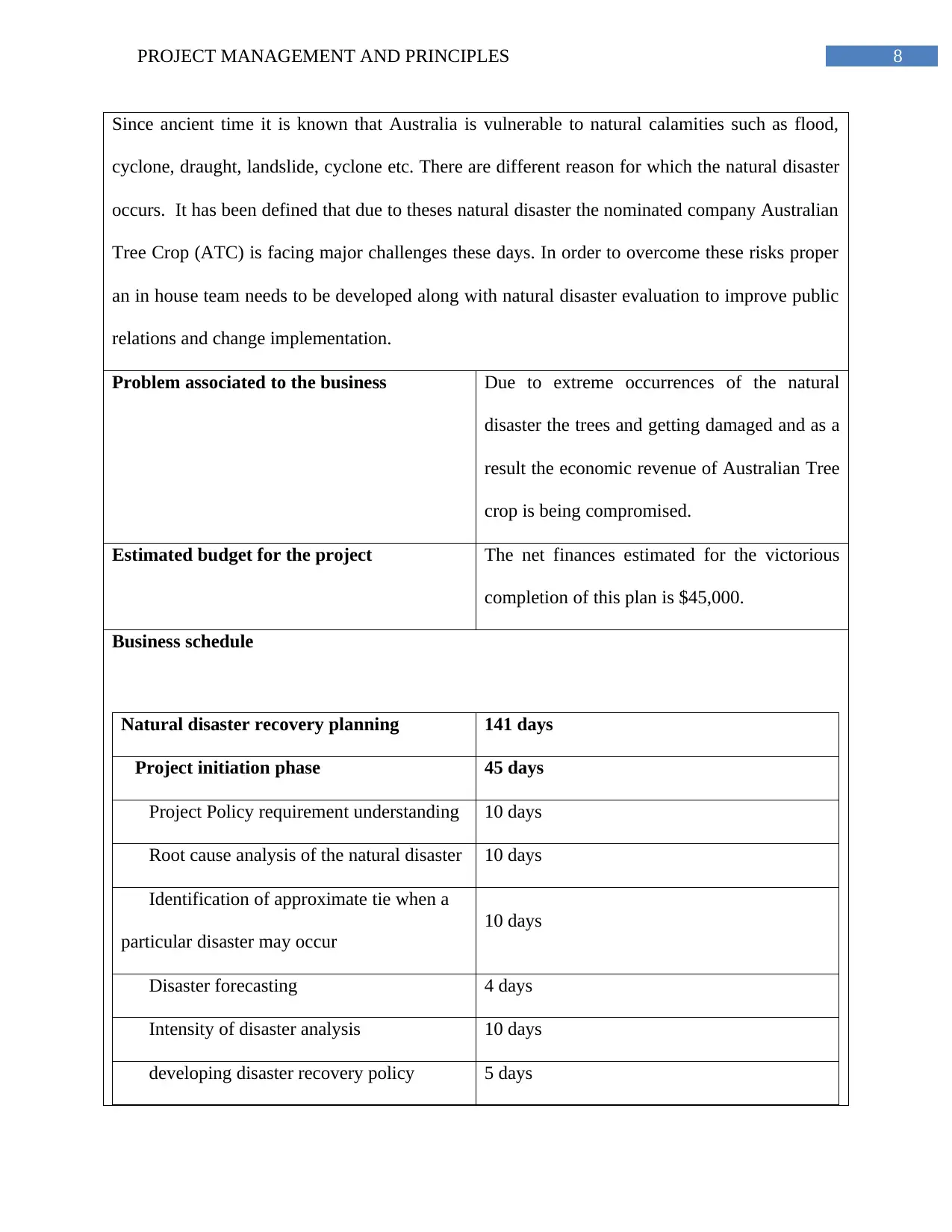
8PROJECT MANAGEMENT AND PRINCIPLES
Since ancient time it is known that Australia is vulnerable to natural calamities such as flood,
cyclone, draught, landslide, cyclone etc. There are different reason for which the natural disaster
occurs. It has been defined that due to theses natural disaster the nominated company Australian
Tree Crop (ATC) is facing major challenges these days. In order to overcome these risks proper
an in house team needs to be developed along with natural disaster evaluation to improve public
relations and change implementation.
Problem associated to the business Due to extreme occurrences of the natural
disaster the trees and getting damaged and as a
result the economic revenue of Australian Tree
crop is being compromised.
Estimated budget for the project The net finances estimated for the victorious
completion of this plan is $45,000.
Business schedule
Natural disaster recovery planning 141 days
Project initiation phase 45 days
Project Policy requirement understanding 10 days
Root cause analysis of the natural disaster 10 days
Identification of approximate tie when a
particular disaster may occur
10 days
Disaster forecasting 4 days
Intensity of disaster analysis 10 days
developing disaster recovery policy 5 days
Since ancient time it is known that Australia is vulnerable to natural calamities such as flood,
cyclone, draught, landslide, cyclone etc. There are different reason for which the natural disaster
occurs. It has been defined that due to theses natural disaster the nominated company Australian
Tree Crop (ATC) is facing major challenges these days. In order to overcome these risks proper
an in house team needs to be developed along with natural disaster evaluation to improve public
relations and change implementation.
Problem associated to the business Due to extreme occurrences of the natural
disaster the trees and getting damaged and as a
result the economic revenue of Australian Tree
crop is being compromised.
Estimated budget for the project The net finances estimated for the victorious
completion of this plan is $45,000.
Business schedule
Natural disaster recovery planning 141 days
Project initiation phase 45 days
Project Policy requirement understanding 10 days
Root cause analysis of the natural disaster 10 days
Identification of approximate tie when a
particular disaster may occur
10 days
Disaster forecasting 4 days
Intensity of disaster analysis 10 days
developing disaster recovery policy 5 days
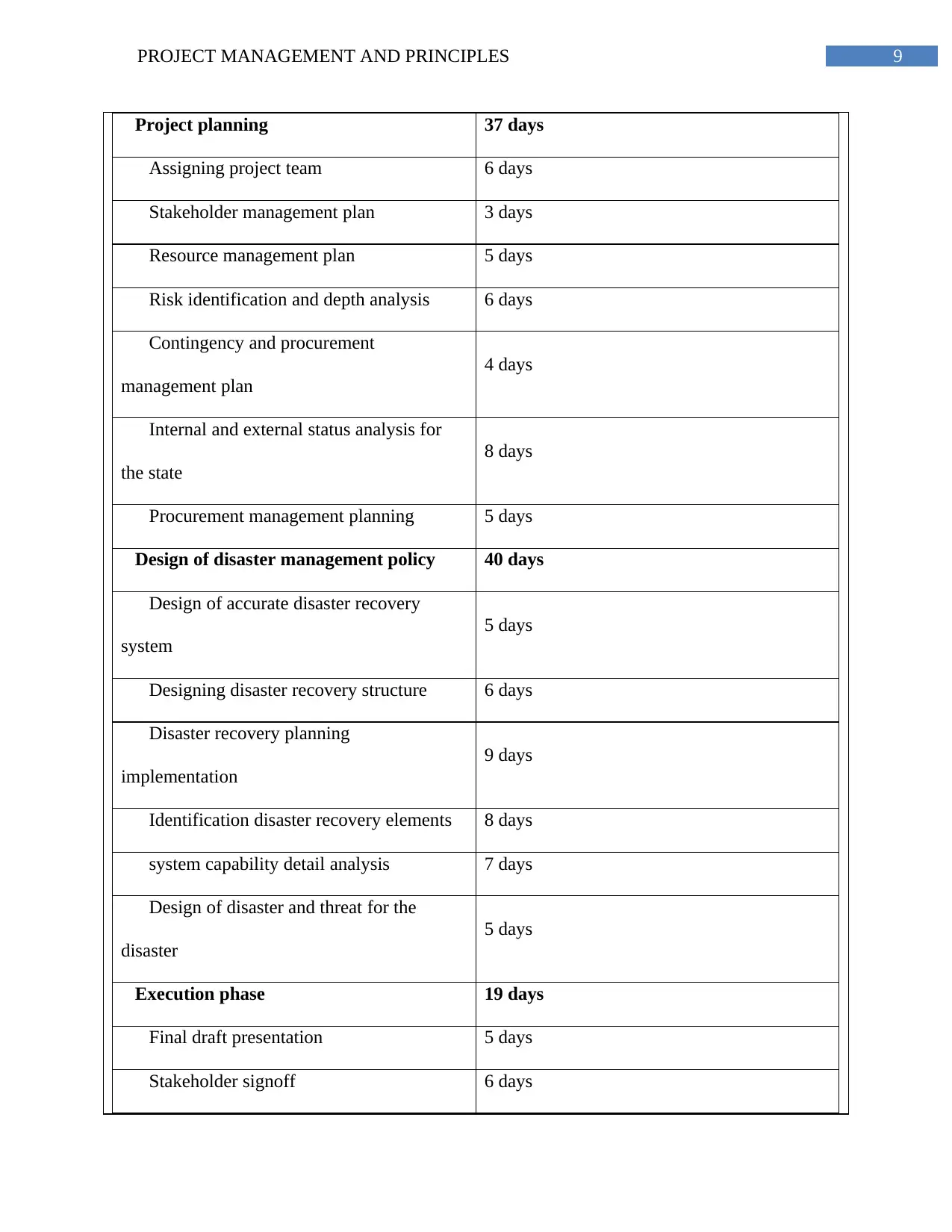
9PROJECT MANAGEMENT AND PRINCIPLES
Project planning 37 days
Assigning project team 6 days
Stakeholder management plan 3 days
Resource management plan 5 days
Risk identification and depth analysis 6 days
Contingency and procurement
management plan
4 days
Internal and external status analysis for
the state
8 days
Procurement management planning 5 days
Design of disaster management policy 40 days
Design of accurate disaster recovery
system
5 days
Designing disaster recovery structure 6 days
Disaster recovery planning
implementation
9 days
Identification disaster recovery elements 8 days
system capability detail analysis 7 days
Design of disaster and threat for the
disaster
5 days
Execution phase 19 days
Final draft presentation 5 days
Stakeholder signoff 6 days
Project planning 37 days
Assigning project team 6 days
Stakeholder management plan 3 days
Resource management plan 5 days
Risk identification and depth analysis 6 days
Contingency and procurement
management plan
4 days
Internal and external status analysis for
the state
8 days
Procurement management planning 5 days
Design of disaster management policy 40 days
Design of accurate disaster recovery
system
5 days
Designing disaster recovery structure 6 days
Disaster recovery planning
implementation
9 days
Identification disaster recovery elements 8 days
system capability detail analysis 7 days
Design of disaster and threat for the
disaster
5 days
Execution phase 19 days
Final draft presentation 5 days
Stakeholder signoff 6 days
Secure Best Marks with AI Grader
Need help grading? Try our AI Grader for instant feedback on your assignments.
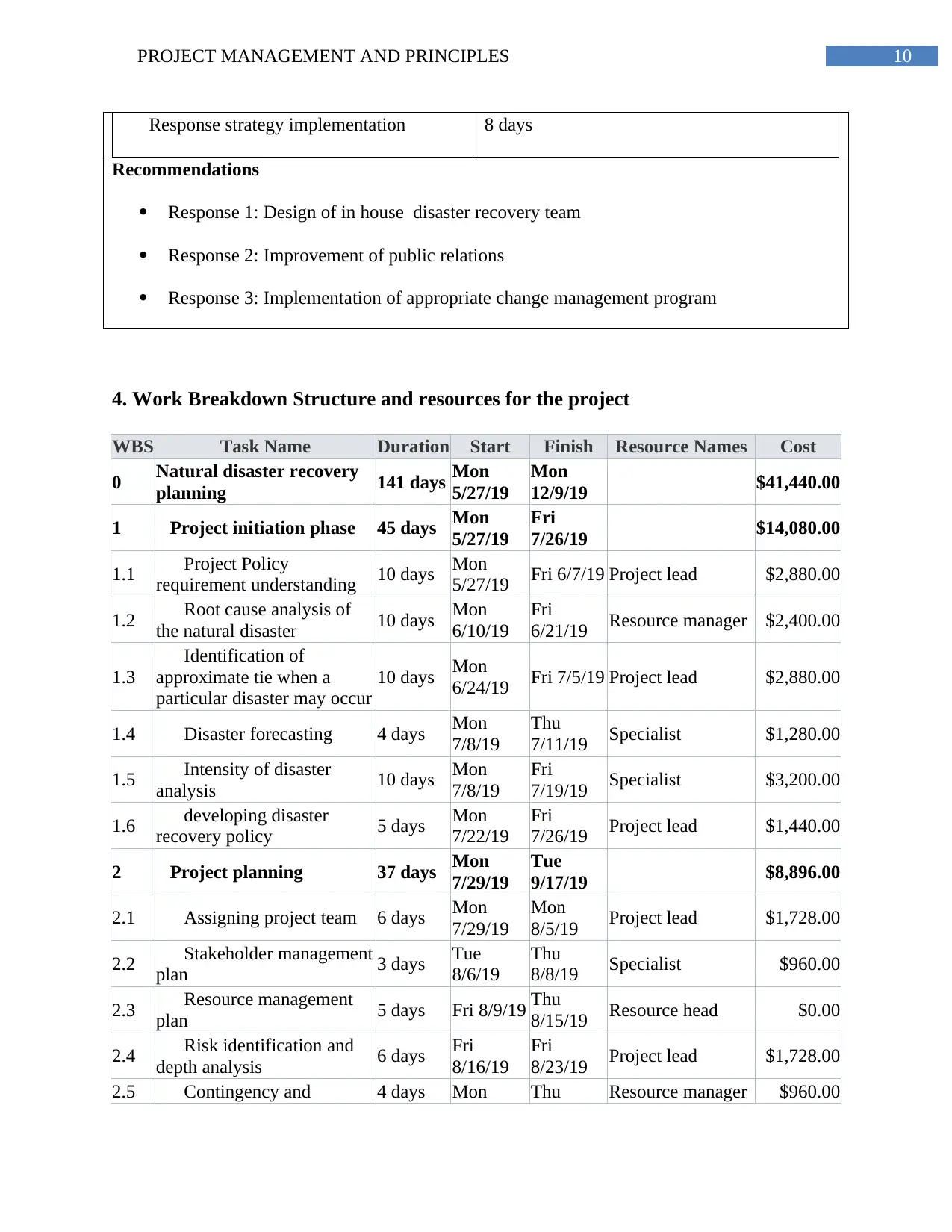
10PROJECT MANAGEMENT AND PRINCIPLES
Response strategy implementation 8 days
Recommendations
Response 1: Design of in house disaster recovery team
Response 2: Improvement of public relations
Response 3: Implementation of appropriate change management program
4. Work Breakdown Structure and resources for the project
WBS Task Name Duration Start Finish Resource Names Cost
0 Natural disaster recovery
planning 141 days Mon
5/27/19
Mon
12/9/19 $41,440.00
1 Project initiation phase 45 days Mon
5/27/19
Fri
7/26/19 $14,080.00
1.1 Project Policy
requirement understanding 10 days Mon
5/27/19 Fri 6/7/19 Project lead $2,880.00
1.2 Root cause analysis of
the natural disaster 10 days Mon
6/10/19
Fri
6/21/19 Resource manager $2,400.00
1.3
Identification of
approximate tie when a
particular disaster may occur
10 days Mon
6/24/19 Fri 7/5/19 Project lead $2,880.00
1.4 Disaster forecasting 4 days Mon
7/8/19
Thu
7/11/19 Specialist $1,280.00
1.5 Intensity of disaster
analysis 10 days Mon
7/8/19
Fri
7/19/19 Specialist $3,200.00
1.6 developing disaster
recovery policy 5 days Mon
7/22/19
Fri
7/26/19 Project lead $1,440.00
2 Project planning 37 days Mon
7/29/19
Tue
9/17/19 $8,896.00
2.1 Assigning project team 6 days Mon
7/29/19
Mon
8/5/19 Project lead $1,728.00
2.2 Stakeholder management
plan 3 days Tue
8/6/19
Thu
8/8/19 Specialist $960.00
2.3 Resource management
plan 5 days Fri 8/9/19 Thu
8/15/19 Resource head $0.00
2.4 Risk identification and
depth analysis 6 days Fri
8/16/19
Fri
8/23/19 Project lead $1,728.00
2.5 Contingency and 4 days Mon Thu Resource manager $960.00
Response strategy implementation 8 days
Recommendations
Response 1: Design of in house disaster recovery team
Response 2: Improvement of public relations
Response 3: Implementation of appropriate change management program
4. Work Breakdown Structure and resources for the project
WBS Task Name Duration Start Finish Resource Names Cost
0 Natural disaster recovery
planning 141 days Mon
5/27/19
Mon
12/9/19 $41,440.00
1 Project initiation phase 45 days Mon
5/27/19
Fri
7/26/19 $14,080.00
1.1 Project Policy
requirement understanding 10 days Mon
5/27/19 Fri 6/7/19 Project lead $2,880.00
1.2 Root cause analysis of
the natural disaster 10 days Mon
6/10/19
Fri
6/21/19 Resource manager $2,400.00
1.3
Identification of
approximate tie when a
particular disaster may occur
10 days Mon
6/24/19 Fri 7/5/19 Project lead $2,880.00
1.4 Disaster forecasting 4 days Mon
7/8/19
Thu
7/11/19 Specialist $1,280.00
1.5 Intensity of disaster
analysis 10 days Mon
7/8/19
Fri
7/19/19 Specialist $3,200.00
1.6 developing disaster
recovery policy 5 days Mon
7/22/19
Fri
7/26/19 Project lead $1,440.00
2 Project planning 37 days Mon
7/29/19
Tue
9/17/19 $8,896.00
2.1 Assigning project team 6 days Mon
7/29/19
Mon
8/5/19 Project lead $1,728.00
2.2 Stakeholder management
plan 3 days Tue
8/6/19
Thu
8/8/19 Specialist $960.00
2.3 Resource management
plan 5 days Fri 8/9/19 Thu
8/15/19 Resource head $0.00
2.4 Risk identification and
depth analysis 6 days Fri
8/16/19
Fri
8/23/19 Project lead $1,728.00
2.5 Contingency and 4 days Mon Thu Resource manager $960.00
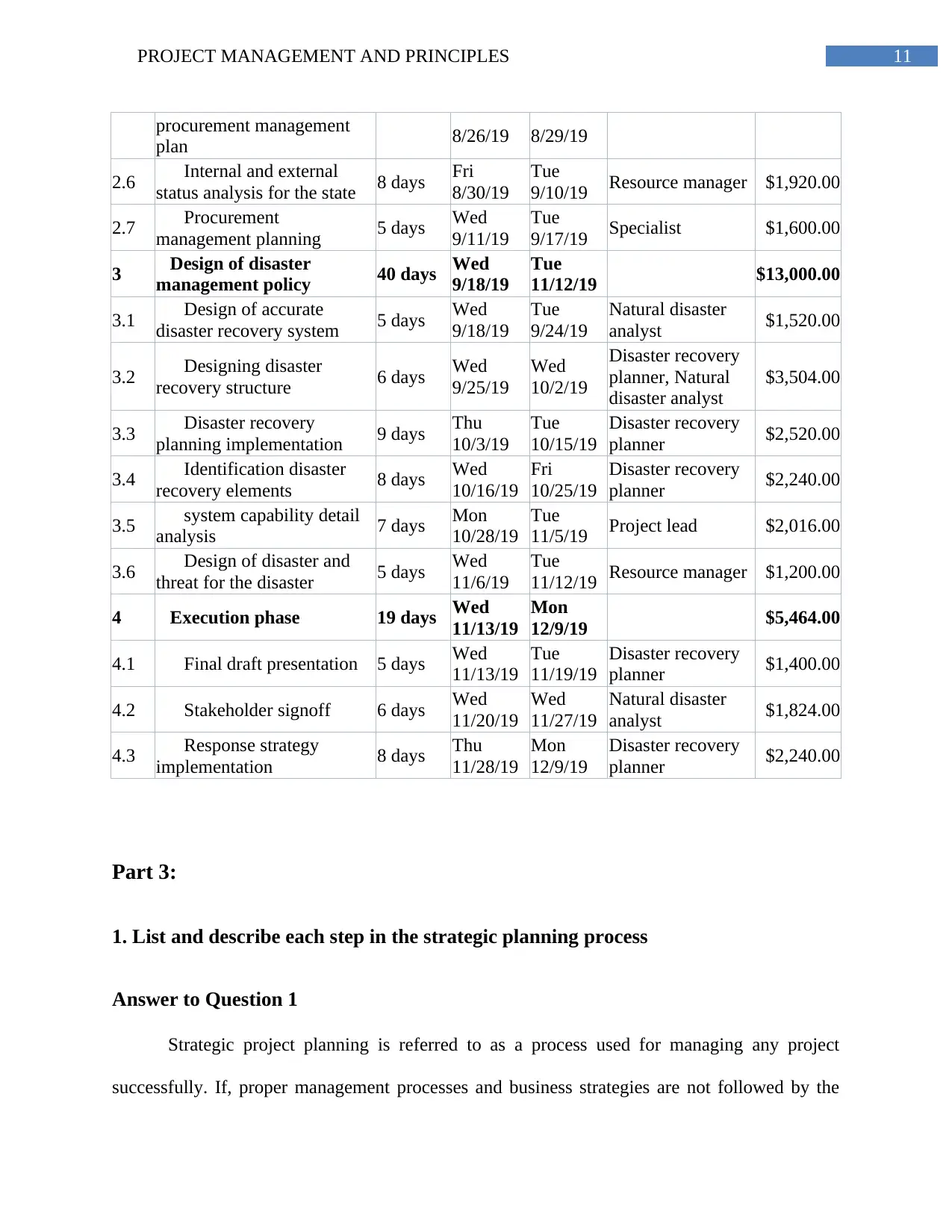
11PROJECT MANAGEMENT AND PRINCIPLES
procurement management
plan 8/26/19 8/29/19
2.6 Internal and external
status analysis for the state 8 days Fri
8/30/19
Tue
9/10/19 Resource manager $1,920.00
2.7 Procurement
management planning 5 days Wed
9/11/19
Tue
9/17/19 Specialist $1,600.00
3 Design of disaster
management policy 40 days Wed
9/18/19
Tue
11/12/19 $13,000.00
3.1 Design of accurate
disaster recovery system 5 days Wed
9/18/19
Tue
9/24/19
Natural disaster
analyst $1,520.00
3.2 Designing disaster
recovery structure 6 days Wed
9/25/19
Wed
10/2/19
Disaster recovery
planner, Natural
disaster analyst
$3,504.00
3.3 Disaster recovery
planning implementation 9 days Thu
10/3/19
Tue
10/15/19
Disaster recovery
planner $2,520.00
3.4 Identification disaster
recovery elements 8 days Wed
10/16/19
Fri
10/25/19
Disaster recovery
planner $2,240.00
3.5 system capability detail
analysis 7 days Mon
10/28/19
Tue
11/5/19 Project lead $2,016.00
3.6 Design of disaster and
threat for the disaster 5 days Wed
11/6/19
Tue
11/12/19 Resource manager $1,200.00
4 Execution phase 19 days Wed
11/13/19
Mon
12/9/19 $5,464.00
4.1 Final draft presentation 5 days Wed
11/13/19
Tue
11/19/19
Disaster recovery
planner $1,400.00
4.2 Stakeholder signoff 6 days Wed
11/20/19
Wed
11/27/19
Natural disaster
analyst $1,824.00
4.3 Response strategy
implementation 8 days Thu
11/28/19
Mon
12/9/19
Disaster recovery
planner $2,240.00
Part 3:
1. List and describe each step in the strategic planning process
Answer to Question 1
Strategic project planning is referred to as a process used for managing any project
successfully. If, proper management processes and business strategies are not followed by the
procurement management
plan 8/26/19 8/29/19
2.6 Internal and external
status analysis for the state 8 days Fri
8/30/19
Tue
9/10/19 Resource manager $1,920.00
2.7 Procurement
management planning 5 days Wed
9/11/19
Tue
9/17/19 Specialist $1,600.00
3 Design of disaster
management policy 40 days Wed
9/18/19
Tue
11/12/19 $13,000.00
3.1 Design of accurate
disaster recovery system 5 days Wed
9/18/19
Tue
9/24/19
Natural disaster
analyst $1,520.00
3.2 Designing disaster
recovery structure 6 days Wed
9/25/19
Wed
10/2/19
Disaster recovery
planner, Natural
disaster analyst
$3,504.00
3.3 Disaster recovery
planning implementation 9 days Thu
10/3/19
Tue
10/15/19
Disaster recovery
planner $2,520.00
3.4 Identification disaster
recovery elements 8 days Wed
10/16/19
Fri
10/25/19
Disaster recovery
planner $2,240.00
3.5 system capability detail
analysis 7 days Mon
10/28/19
Tue
11/5/19 Project lead $2,016.00
3.6 Design of disaster and
threat for the disaster 5 days Wed
11/6/19
Tue
11/12/19 Resource manager $1,200.00
4 Execution phase 19 days Wed
11/13/19
Mon
12/9/19 $5,464.00
4.1 Final draft presentation 5 days Wed
11/13/19
Tue
11/19/19
Disaster recovery
planner $1,400.00
4.2 Stakeholder signoff 6 days Wed
11/20/19
Wed
11/27/19
Natural disaster
analyst $1,824.00
4.3 Response strategy
implementation 8 days Thu
11/28/19
Mon
12/9/19
Disaster recovery
planner $2,240.00
Part 3:
1. List and describe each step in the strategic planning process
Answer to Question 1
Strategic project planning is referred to as a process used for managing any project
successfully. If, proper management processes and business strategies are not followed by the
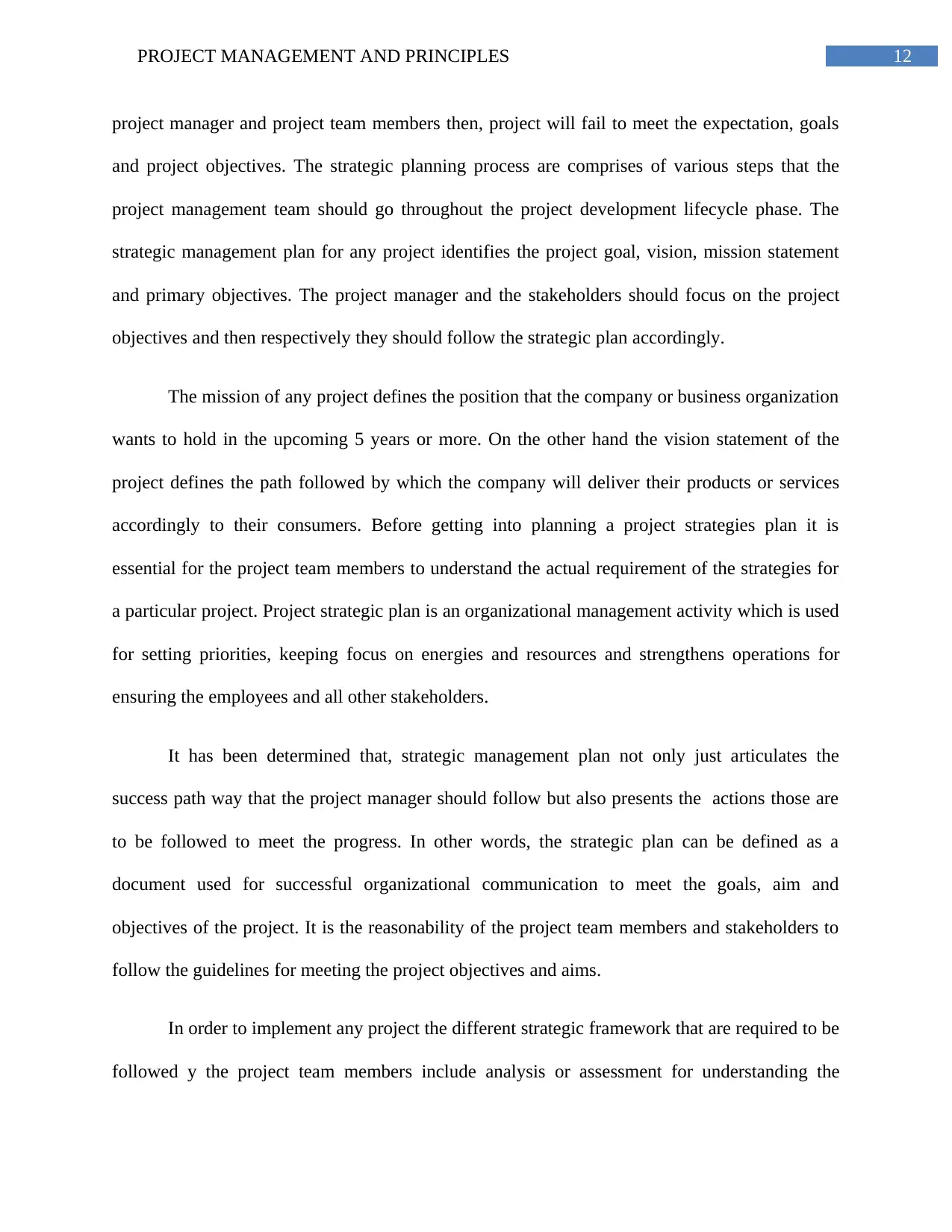
12PROJECT MANAGEMENT AND PRINCIPLES
project manager and project team members then, project will fail to meet the expectation, goals
and project objectives. The strategic planning process are comprises of various steps that the
project management team should go throughout the project development lifecycle phase. The
strategic management plan for any project identifies the project goal, vision, mission statement
and primary objectives. The project manager and the stakeholders should focus on the project
objectives and then respectively they should follow the strategic plan accordingly.
The mission of any project defines the position that the company or business organization
wants to hold in the upcoming 5 years or more. On the other hand the vision statement of the
project defines the path followed by which the company will deliver their products or services
accordingly to their consumers. Before getting into planning a project strategies plan it is
essential for the project team members to understand the actual requirement of the strategies for
a particular project. Project strategic plan is an organizational management activity which is used
for setting priorities, keeping focus on energies and resources and strengthens operations for
ensuring the employees and all other stakeholders.
It has been determined that, strategic management plan not only just articulates the
success path way that the project manager should follow but also presents the actions those are
to be followed to meet the progress. In other words, the strategic plan can be defined as a
document used for successful organizational communication to meet the goals, aim and
objectives of the project. It is the reasonability of the project team members and stakeholders to
follow the guidelines for meeting the project objectives and aims.
In order to implement any project the different strategic framework that are required to be
followed y the project team members include analysis or assessment for understanding the
project manager and project team members then, project will fail to meet the expectation, goals
and project objectives. The strategic planning process are comprises of various steps that the
project management team should go throughout the project development lifecycle phase. The
strategic management plan for any project identifies the project goal, vision, mission statement
and primary objectives. The project manager and the stakeholders should focus on the project
objectives and then respectively they should follow the strategic plan accordingly.
The mission of any project defines the position that the company or business organization
wants to hold in the upcoming 5 years or more. On the other hand the vision statement of the
project defines the path followed by which the company will deliver their products or services
accordingly to their consumers. Before getting into planning a project strategies plan it is
essential for the project team members to understand the actual requirement of the strategies for
a particular project. Project strategic plan is an organizational management activity which is used
for setting priorities, keeping focus on energies and resources and strengthens operations for
ensuring the employees and all other stakeholders.
It has been determined that, strategic management plan not only just articulates the
success path way that the project manager should follow but also presents the actions those are
to be followed to meet the progress. In other words, the strategic plan can be defined as a
document used for successful organizational communication to meet the goals, aim and
objectives of the project. It is the reasonability of the project team members and stakeholders to
follow the guidelines for meeting the project objectives and aims.
In order to implement any project the different strategic framework that are required to be
followed y the project team members include analysis or assessment for understanding the
Paraphrase This Document
Need a fresh take? Get an instant paraphrase of this document with our AI Paraphraser
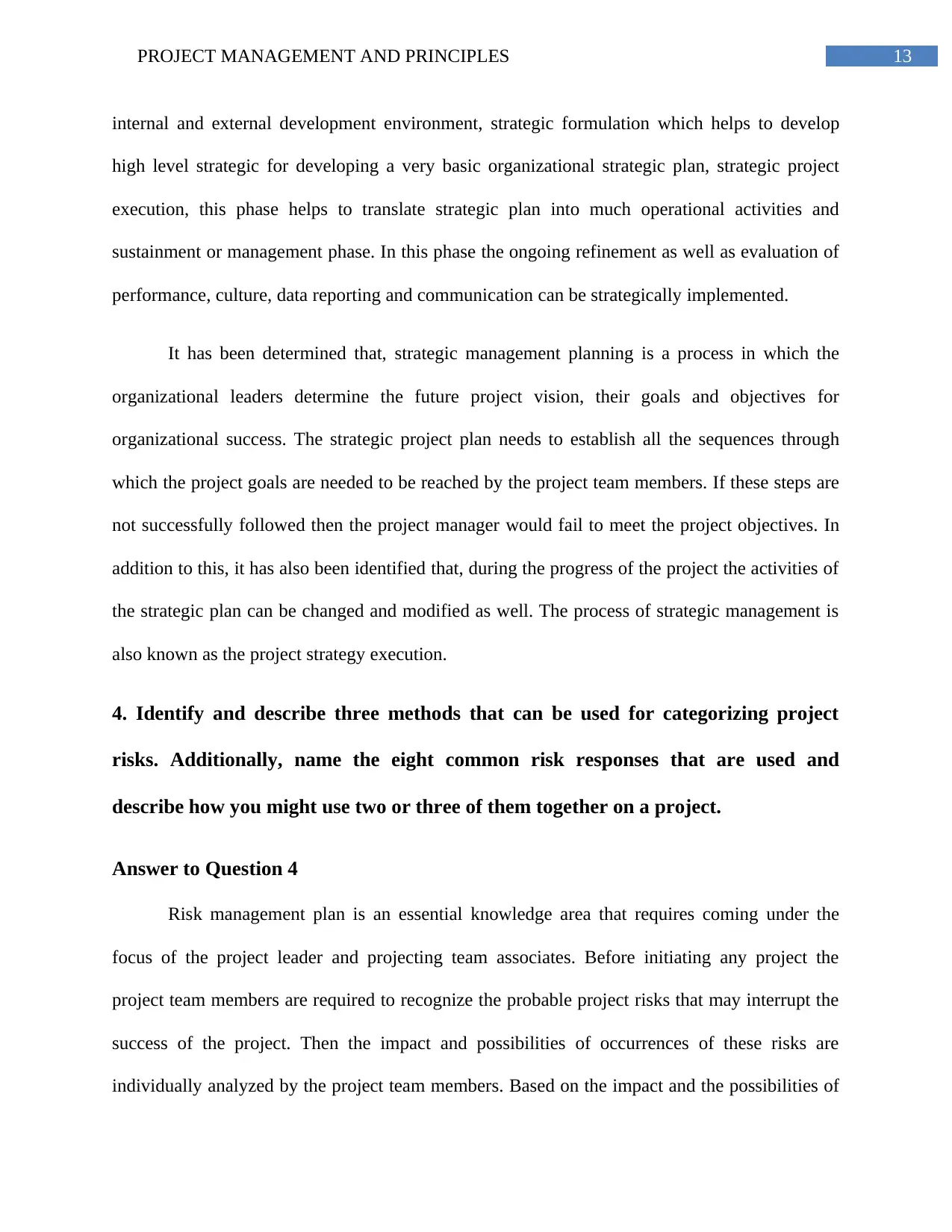
13PROJECT MANAGEMENT AND PRINCIPLES
internal and external development environment, strategic formulation which helps to develop
high level strategic for developing a very basic organizational strategic plan, strategic project
execution, this phase helps to translate strategic plan into much operational activities and
sustainment or management phase. In this phase the ongoing refinement as well as evaluation of
performance, culture, data reporting and communication can be strategically implemented.
It has been determined that, strategic management planning is a process in which the
organizational leaders determine the future project vision, their goals and objectives for
organizational success. The strategic project plan needs to establish all the sequences through
which the project goals are needed to be reached by the project team members. If these steps are
not successfully followed then the project manager would fail to meet the project objectives. In
addition to this, it has also been identified that, during the progress of the project the activities of
the strategic plan can be changed and modified as well. The process of strategic management is
also known as the project strategy execution.
4. Identify and describe three methods that can be used for categorizing project
risks. Additionally, name the eight common risk responses that are used and
describe how you might use two or three of them together on a project.
Answer to Question 4
Risk management plan is an essential knowledge area that requires coming under the
focus of the project leader and projecting team associates. Before initiating any project the
project team members are required to recognize the probable project risks that may interrupt the
success of the project. Then the impact and possibilities of occurrences of these risks are
individually analyzed by the project team members. Based on the impact and the possibilities of
internal and external development environment, strategic formulation which helps to develop
high level strategic for developing a very basic organizational strategic plan, strategic project
execution, this phase helps to translate strategic plan into much operational activities and
sustainment or management phase. In this phase the ongoing refinement as well as evaluation of
performance, culture, data reporting and communication can be strategically implemented.
It has been determined that, strategic management planning is a process in which the
organizational leaders determine the future project vision, their goals and objectives for
organizational success. The strategic project plan needs to establish all the sequences through
which the project goals are needed to be reached by the project team members. If these steps are
not successfully followed then the project manager would fail to meet the project objectives. In
addition to this, it has also been identified that, during the progress of the project the activities of
the strategic plan can be changed and modified as well. The process of strategic management is
also known as the project strategy execution.
4. Identify and describe three methods that can be used for categorizing project
risks. Additionally, name the eight common risk responses that are used and
describe how you might use two or three of them together on a project.
Answer to Question 4
Risk management plan is an essential knowledge area that requires coming under the
focus of the project leader and projecting team associates. Before initiating any project the
project team members are required to recognize the probable project risks that may interrupt the
success of the project. Then the impact and possibilities of occurrences of these risks are
individually analyzed by the project team members. Based on the impact and the possibilities of

14PROJECT MANAGEMENT AND PRINCIPLES
the risks the project score is identified or the project is ranked. Considering the project risk
priorities, proper risk managing strategies and risk management practices are needed to be
developed by the project team members.
Different risk categorization approaches are available in the field of project management
and the project manager is required to identify the most suitable risk categorization method. It
has been determined that, internal risks those are relative to an organization can be successfully
controlled. External risks cannot be easily controlled. In order to eliminate risks the project
associates should identify three risk categories such as internal, external and strategic. Three
different risks categories are there and the details of the categories are elaborated in the below
section:
Internal risk: Internal risk category is referred to as that one particular area where
particular rue based approaches for managing risks may be sufficient to eliminate and mitigate
any risk. This approach helps to identify all the internal risks. It has been determined that, risk
can be effectively managed and resolved any compliance with professionally developed rules
and project policies. This risk categorization approach will help to avoid surprise situations by
proving structured, focused approaches for identifying different problems. It also helps to
identify and implement risk mitigation techniques. It will also enhance the organizational
communication approach.
Strategic risk: While implementing any project strategies it is essential for the project
managers to identify the project strategies appropriately. If any of these strategies are not
accurately followed and implemented then organization may face serious strategic risks.
Elimination of strategic risks is much complex than, internal and external risk categorization. In
the risks the project score is identified or the project is ranked. Considering the project risk
priorities, proper risk managing strategies and risk management practices are needed to be
developed by the project team members.
Different risk categorization approaches are available in the field of project management
and the project manager is required to identify the most suitable risk categorization method. It
has been determined that, internal risks those are relative to an organization can be successfully
controlled. External risks cannot be easily controlled. In order to eliminate risks the project
associates should identify three risk categories such as internal, external and strategic. Three
different risks categories are there and the details of the categories are elaborated in the below
section:
Internal risk: Internal risk category is referred to as that one particular area where
particular rue based approaches for managing risks may be sufficient to eliminate and mitigate
any risk. This approach helps to identify all the internal risks. It has been determined that, risk
can be effectively managed and resolved any compliance with professionally developed rules
and project policies. This risk categorization approach will help to avoid surprise situations by
proving structured, focused approaches for identifying different problems. It also helps to
identify and implement risk mitigation techniques. It will also enhance the organizational
communication approach.
Strategic risk: While implementing any project strategies it is essential for the project
managers to identify the project strategies appropriately. If any of these strategies are not
accurately followed and implemented then organization may face serious strategic risks.
Elimination of strategic risks is much complex than, internal and external risk categorization. In
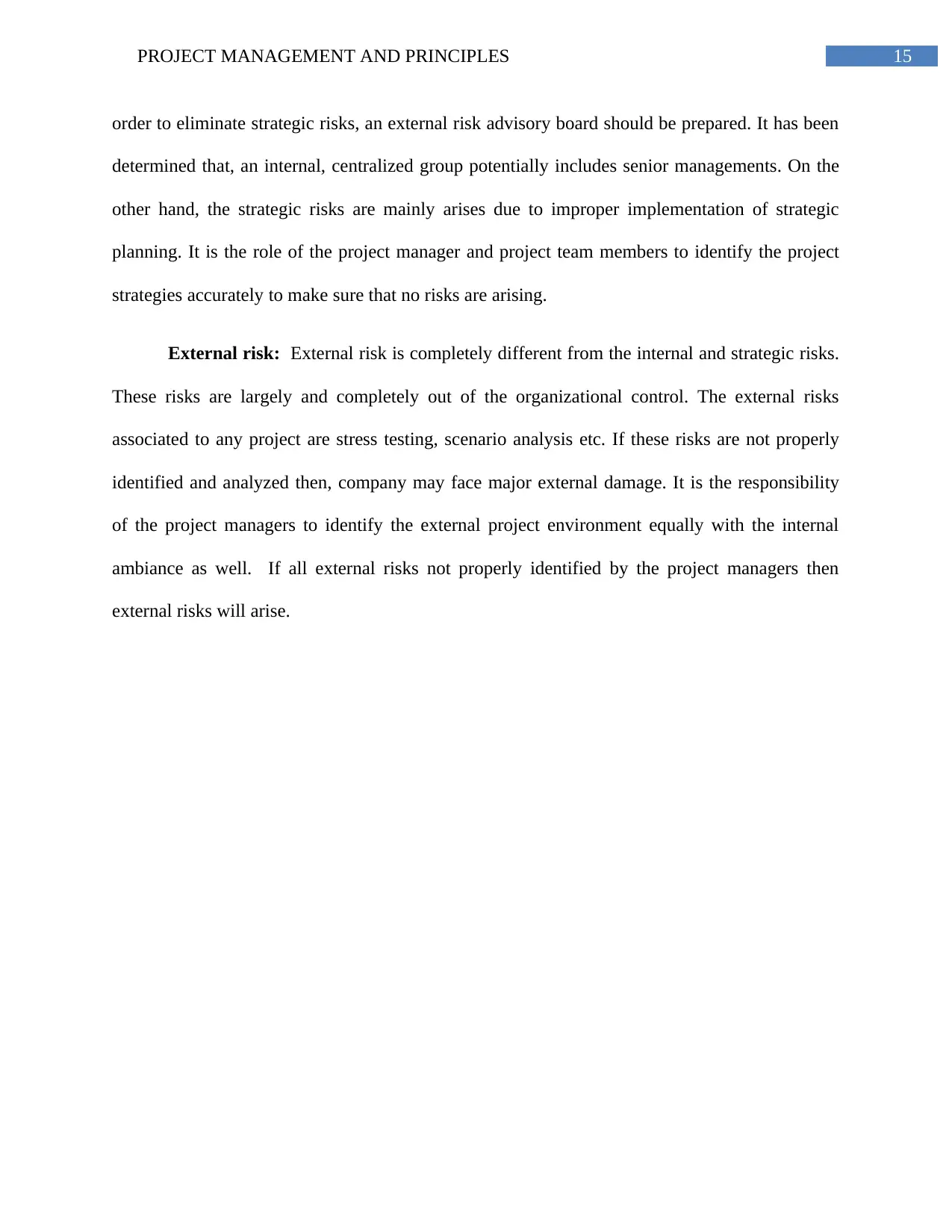
15PROJECT MANAGEMENT AND PRINCIPLES
order to eliminate strategic risks, an external risk advisory board should be prepared. It has been
determined that, an internal, centralized group potentially includes senior managements. On the
other hand, the strategic risks are mainly arises due to improper implementation of strategic
planning. It is the role of the project manager and project team members to identify the project
strategies accurately to make sure that no risks are arising.
External risk: External risk is completely different from the internal and strategic risks.
These risks are largely and completely out of the organizational control. The external risks
associated to any project are stress testing, scenario analysis etc. If these risks are not properly
identified and analyzed then, company may face major external damage. It is the responsibility
of the project managers to identify the external project environment equally with the internal
ambiance as well. If all external risks not properly identified by the project managers then
external risks will arise.
order to eliminate strategic risks, an external risk advisory board should be prepared. It has been
determined that, an internal, centralized group potentially includes senior managements. On the
other hand, the strategic risks are mainly arises due to improper implementation of strategic
planning. It is the role of the project manager and project team members to identify the project
strategies accurately to make sure that no risks are arising.
External risk: External risk is completely different from the internal and strategic risks.
These risks are largely and completely out of the organizational control. The external risks
associated to any project are stress testing, scenario analysis etc. If these risks are not properly
identified and analyzed then, company may face major external damage. It is the responsibility
of the project managers to identify the external project environment equally with the internal
ambiance as well. If all external risks not properly identified by the project managers then
external risks will arise.
Secure Best Marks with AI Grader
Need help grading? Try our AI Grader for instant feedback on your assignments.
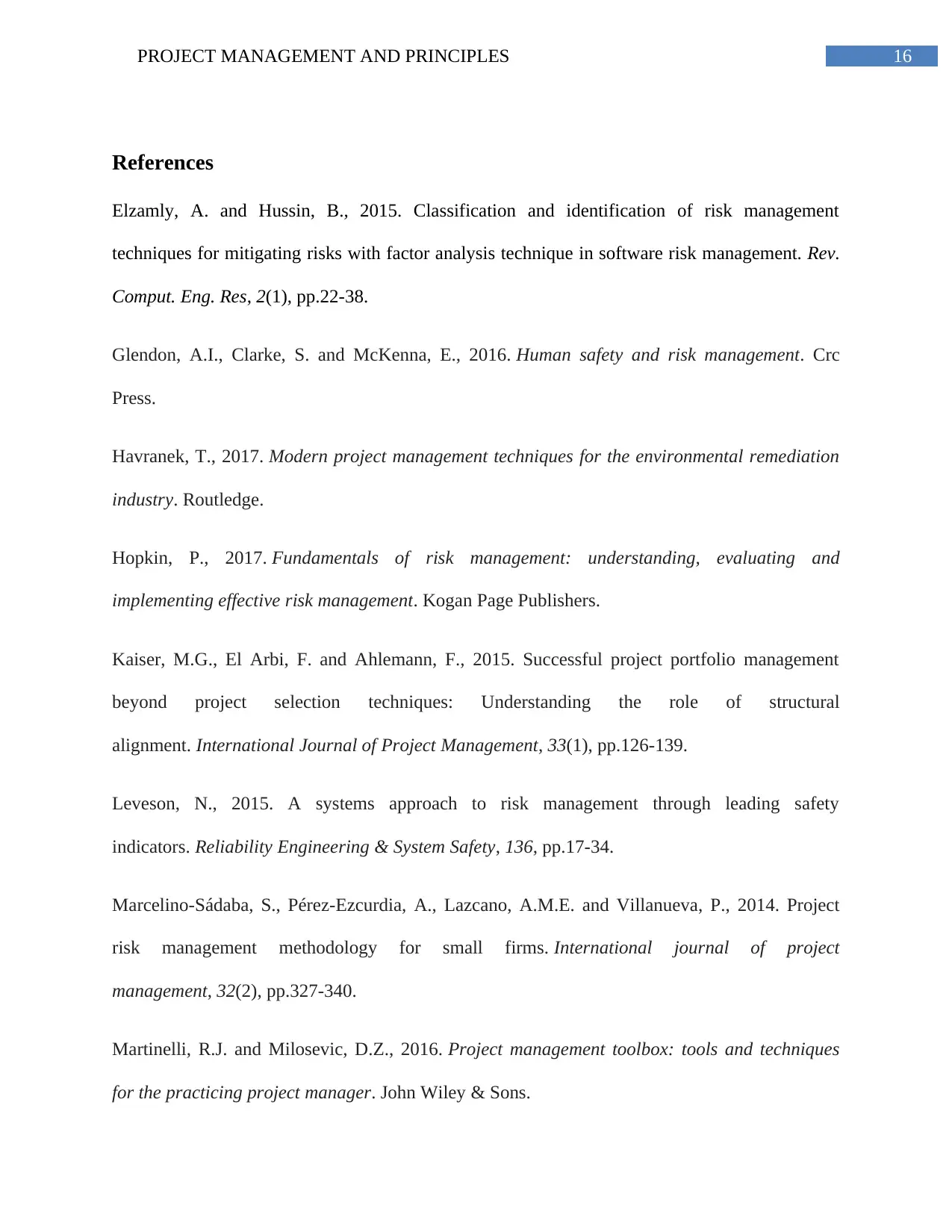
16PROJECT MANAGEMENT AND PRINCIPLES
References
Elzamly, A. and Hussin, B., 2015. Classification and identification of risk management
techniques for mitigating risks with factor analysis technique in software risk management. Rev.
Comput. Eng. Res, 2(1), pp.22-38.
Glendon, A.I., Clarke, S. and McKenna, E., 2016. Human safety and risk management. Crc
Press.
Havranek, T., 2017. Modern project management techniques for the environmental remediation
industry. Routledge.
Hopkin, P., 2017. Fundamentals of risk management: understanding, evaluating and
implementing effective risk management. Kogan Page Publishers.
Kaiser, M.G., El Arbi, F. and Ahlemann, F., 2015. Successful project portfolio management
beyond project selection techniques: Understanding the role of structural
alignment. International Journal of Project Management, 33(1), pp.126-139.
Leveson, N., 2015. A systems approach to risk management through leading safety
indicators. Reliability Engineering & System Safety, 136, pp.17-34.
Marcelino-Sádaba, S., Pérez-Ezcurdia, A., Lazcano, A.M.E. and Villanueva, P., 2014. Project
risk management methodology for small firms. International journal of project
management, 32(2), pp.327-340.
Martinelli, R.J. and Milosevic, D.Z., 2016. Project management toolbox: tools and techniques
for the practicing project manager. John Wiley & Sons.
References
Elzamly, A. and Hussin, B., 2015. Classification and identification of risk management
techniques for mitigating risks with factor analysis technique in software risk management. Rev.
Comput. Eng. Res, 2(1), pp.22-38.
Glendon, A.I., Clarke, S. and McKenna, E., 2016. Human safety and risk management. Crc
Press.
Havranek, T., 2017. Modern project management techniques for the environmental remediation
industry. Routledge.
Hopkin, P., 2017. Fundamentals of risk management: understanding, evaluating and
implementing effective risk management. Kogan Page Publishers.
Kaiser, M.G., El Arbi, F. and Ahlemann, F., 2015. Successful project portfolio management
beyond project selection techniques: Understanding the role of structural
alignment. International Journal of Project Management, 33(1), pp.126-139.
Leveson, N., 2015. A systems approach to risk management through leading safety
indicators. Reliability Engineering & System Safety, 136, pp.17-34.
Marcelino-Sádaba, S., Pérez-Ezcurdia, A., Lazcano, A.M.E. and Villanueva, P., 2014. Project
risk management methodology for small firms. International journal of project
management, 32(2), pp.327-340.
Martinelli, R.J. and Milosevic, D.Z., 2016. Project management toolbox: tools and techniques
for the practicing project manager. John Wiley & Sons.
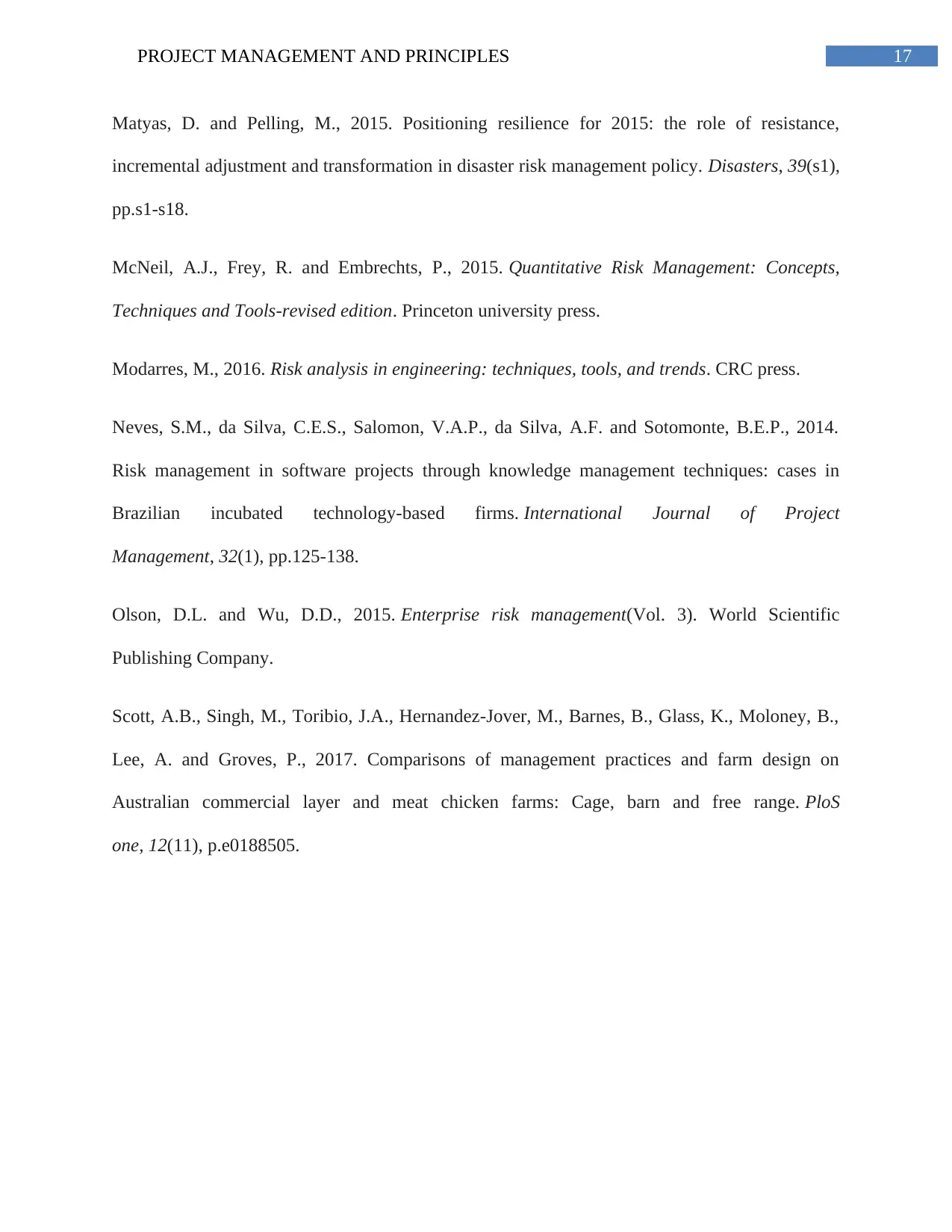
17PROJECT MANAGEMENT AND PRINCIPLES
Matyas, D. and Pelling, M., 2015. Positioning resilience for 2015: the role of resistance,
incremental adjustment and transformation in disaster risk management policy. Disasters, 39(s1),
pp.s1-s18.
McNeil, A.J., Frey, R. and Embrechts, P., 2015. Quantitative Risk Management: Concepts,
Techniques and Tools-revised edition. Princeton university press.
Modarres, M., 2016. Risk analysis in engineering: techniques, tools, and trends. CRC press.
Neves, S.M., da Silva, C.E.S., Salomon, V.A.P., da Silva, A.F. and Sotomonte, B.E.P., 2014.
Risk management in software projects through knowledge management techniques: cases in
Brazilian incubated technology-based firms. International Journal of Project
Management, 32(1), pp.125-138.
Olson, D.L. and Wu, D.D., 2015. Enterprise risk management(Vol. 3). World Scientific
Publishing Company.
Scott, A.B., Singh, M., Toribio, J.A., Hernandez-Jover, M., Barnes, B., Glass, K., Moloney, B.,
Lee, A. and Groves, P., 2017. Comparisons of management practices and farm design on
Australian commercial layer and meat chicken farms: Cage, barn and free range. PloS
one, 12(11), p.e0188505.
Matyas, D. and Pelling, M., 2015. Positioning resilience for 2015: the role of resistance,
incremental adjustment and transformation in disaster risk management policy. Disasters, 39(s1),
pp.s1-s18.
McNeil, A.J., Frey, R. and Embrechts, P., 2015. Quantitative Risk Management: Concepts,
Techniques and Tools-revised edition. Princeton university press.
Modarres, M., 2016. Risk analysis in engineering: techniques, tools, and trends. CRC press.
Neves, S.M., da Silva, C.E.S., Salomon, V.A.P., da Silva, A.F. and Sotomonte, B.E.P., 2014.
Risk management in software projects through knowledge management techniques: cases in
Brazilian incubated technology-based firms. International Journal of Project
Management, 32(1), pp.125-138.
Olson, D.L. and Wu, D.D., 2015. Enterprise risk management(Vol. 3). World Scientific
Publishing Company.
Scott, A.B., Singh, M., Toribio, J.A., Hernandez-Jover, M., Barnes, B., Glass, K., Moloney, B.,
Lee, A. and Groves, P., 2017. Comparisons of management practices and farm design on
Australian commercial layer and meat chicken farms: Cage, barn and free range. PloS
one, 12(11), p.e0188505.
1 out of 18
Related Documents
Your All-in-One AI-Powered Toolkit for Academic Success.
+13062052269
info@desklib.com
Available 24*7 on WhatsApp / Email
![[object Object]](/_next/static/media/star-bottom.7253800d.svg)
Unlock your academic potential
© 2024 | Zucol Services PVT LTD | All rights reserved.





